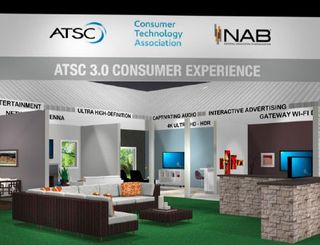From Here to ATSC

Related: Chernock: FCC Spectrum Auction Has ATSC 3.0 Implications
Mark Richer, president of the Advanced Television Systems Committee (ATSC), is pretty sure most major broadcasting executives have been properly briefed by their engineers on the possibilities offered by ATSC 3.0.
But hearing promises about being able to deliver over-the-air services such as targeted advertising, 4K resolution and high dynamic range (HDR) is one thing. At the NAB Show, Richer says they’ll see much more of the standard’s true potential in action.
“There are so many things ATSC 3.0 can do, and so many things it can enable, it’s hard to emphasize any one of them,” Richer said. “The possibilities for businesses, new public services and new products is tremendous.… And we’re not even able to show it all.”
There will be no shortage of ATSC 3.0-enabled products and technologies to see at NAB—including live ATSC 3.0 transmissions from the show floor—even as ATSC members work to finalize its suite of standards by the end of the year. The conference will see two new exhibit areas dedicated exclusively to ATSC 3.0, one showing what consumers can expect from the technology, another showing broadcasters what it’s going to take to deliver it, with approximately 30 companies—big and small—involved.
Dolby will show off ATSC 3.0 broadcast delivery of its HDR tech Dolby Vision. LG Electronics (which delivered an end-to-end, live 4K broadcast test using the ATSC 3.0 standard in February) will demonstrate the delivery of multiple digital services via a single RF channel, using ATSC 3.0. Pearl TV and Samsung have teamed up to show how broadcasters can use the standard to deliver both video-on-demand and targeted advertising.
And it’s not just the headline-grabbing tech giants lining up behind the IP-based broadcast system. Avateq, Enensys, Junger Audio, Linear Acoustic, Verance and Unisoft are among the other notable companies at NAB showing they have some skin in the new standard’s game.
Broadcasting & Cable Newsletter
The smarter way to stay on top of broadcasting and cable industry. Sign up below
“ATSC 3.0 will offer broadcasters new interactive audio features…as simple as using your remote to select a preset button on your TV screen; or, if you’re an enthusiast, making your own mix of the different audio elements in the broadcast,” said Robert Bleidt, GM of audio and multimedia for Fraunhofer U.S.A. Digital Media Technologies, a San Jose, Calif.-based audio tech company exhibiting its ATSC 3.0 solutions at NAB. “Because of ATSC 3.0, a broadcaster can send additional audio elements as separate audio objects that are mixed in the receiver.”
The 5,000-plus member Society of Broadcast Engineers (SBE), a supporter of ATSC 3.0, sees the standard giving stations the ability to tailor broadcasts to audiences in ways it’s never been able to before, a spokesman told B&C. And while there’s both regulatory and technical work that still needs to be done, the ATSC 3.0 support seen at NAB 2016 is more than promising.
“All of the exhibitors, along with a couple of over-the-air demonstrations, prove there is exciting interest by the equipment manufacturing community to invest time and resources into making ATSC 3.0 a reality,” the SBE spokesman said. “Seeing an over-the-air demonstration is always gratifying because you see what has been talked about beginning to come to reality.”
And heading into the NAB Show, a coalition of industry groups backing ATSC 3.0—including the National Association of Broadcasters (NAB), Consumer Technology Association (CTA), the Advanced Warning and Response Network Alliance (AWARN) and America’s Public Television Stations (APTS)—petitioned the FCC for approval of the core transmission technology of the standard, giving both receiver manufacturers and local broadcasters the option to adopt it.
The petition also calls for FCC rule changes, permitting local simulcasting—a move that would allow ATSC 3.0 to be deployed in conjunction with current digital TV broadcasts without any interruption for viewers.
